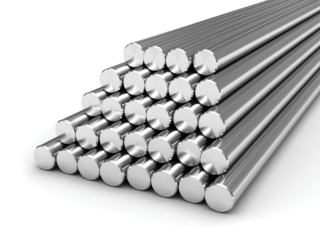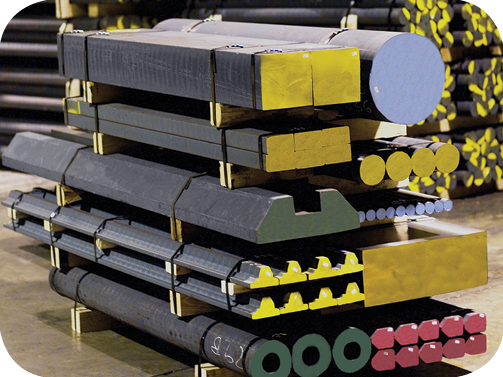The term bar stock is often used in fluid power settings, but it can refer to either one of two quite different things. It can mean piston rod bar stock, the metal rods used in cylinders, or the metal used for manifolds, subplate mounts, and plumbing. This section will examine all of these uses. 
Piston rod bar stock
Hydraulic cylinders are the essence of fluid power motivation. However, their simplicity often leads us to discount their subtleties of manufacture, often assuming they’re constructed of identical stock. You’d be surprised, then, to discover the devil is in the details, and not all cylinders are fabricated equally. One factor often overlooked is the bar stock used for piston rod construction. To help with the finer points of bar stock, we employed the help of Adam Hart, plant manager at Higginson Equipment in Burlington, Ontario.
Piston rod stock is nearly as varied as what is produced from the steel industry, but some are more common than others.
“The most common bar stock material by far, is 75 kpsi 0.0005-in. (1/2 thou) chrome plated steel bar,” said Hart. “There are also many other options. With a steel piston rod, you can increase the tensile strength … up to 100 kpsi, and the chrome can be increased to 0.001.” He is describing the tensile strength and the chrome plate thickness of the bar stock, which is important because most cylinders spend half their time pulling. Additionally, thicker chrome results in superior corrosion resistance.
Other techniques are employed to strengthen the rod stock.
“Most large diameter piston rods are induction hardened, which helps improve impact resistance,” said Hart. “If an end user keeps breaking male rod threads, sometimes this stronger material can help improve the longevity of the cylinder.”
Regarding cylinder finish treatments, in extreme conditions, such as corrosive or salinated fluid exposure, rod stock can be further upgraded to stainless steel.
“Some end users require corrosion resistance for their process, which is where stainless steel steps in,” said Hart. “Most grades of stainless steel can have a chrome finish.” However, stainless steel is not the only finish available. “Aside from chrome, the only other common finish treatment for piston rods is nitride. This is an extremely durable finish. It is a chemical process that hardens and darkens the material, which provides wear and corrosion resistance.”
Hart revealed what he wishes engineers and end-users would consider when designing and applying a cylinder application.
“I would like engineers and end-users to keep in mind, wherever there may be misalignment issues, a female rod thread with a stud may decrease downtime. If you break the attachment off the end of a rod, it is a relatively simple to replace the stud and attachment without the need of replacing the entire rod,” he said.
Bar stock for manifolds
Bar stock may be used either as a mounting for other valve systems or simply for consolidation of plumbing. The bar stock itself is typically an alloy of either aluminum or ductile iron, and is manufactured in billets suitable for machining finished product. The most popular use is the bar stock manifold, which is a block of varying length drilled with passages, ports and bolt holes for mounting valve systems.
Aluminum is a popular choice for bar stock material when system pressure is 3,000 psi or less. It is easier to work with than ductile iron, and is also lower in physical mass and overall cost. However, when working pressure is higher than 3,000 psi, iron is required to withstand the additional stress. Ductile iron, such as Dura-Bar, is a continuous cast (iron) that is less brittle than standard cast iron and is pressure rated to 6,500 psi. Ductile iron is a compound with a highly controlled microstructure, improving strength and machinability. Although forged steel is another option for bar stock, it is rarely used on less than the most extreme applications.
Whatever name you know them by best—ISO, cetop, NG6, D03—the industry standard modular stackable valves are the most common system of circuit construction, and they all require a manifold to interface with. A manifold for a D03 valve, for example, is around 3 in. tall and 3 in. deep, but can be as long as needed to mount any number of valve stacks. The manifold most often has pressure and tank drillings running its length. Each “station” of the manifold, where the valve mounts with four bolts, has four drillings mating up with the pressure and tank passages, as well as mating up with the work ports, which are drilled on the side of the manifold in a vertical arrangement. Bar stock manifolds can be drilled as either parallel or series circuits, depending on the application.
Bar stock can be cut into smaller slices and drilled in similar arrangements to bar manifolds to create subplate mounts. The subplates allow one valve to mount atop, with four ports on each of the four sides. Bottom-ported subplates are also available, but are rarely used, because of their tricky mounting, and ports all on one surface, making plumbing difficult. Bar manifolds have plenty of material to enable the addition of a relief valve cavity, but subplates have no such luxury of real estate. Both manifolds and subplates are available in sizes from D02 to D08, and many manifold accessories are available to help complete the hydraulic circuit, such as tapping plates, cover plates and gauge blocks.
Bar stock can also be used to clean up plumbing on machines by reducing the need for adapters and fittings. By drilling ports into a bar, a header or manifold can provide a junction to common feed or return lines, so that each tube or hose plumbs neatly into the same source. Manifolds and headers can reduce leak points, but also add a look of professionalism compared to a mess of tees and adapters. Bar stock is great for mounting components, such as test points, transducers or pressure switches. The bar material can also be anodized any color, or even just treated for corrosion resistance by clear anodizing for aluminum or nickel plating for ductile iron. Lastly, because bar stock is so commonly used in various applications, it is readily available through every fluid power distributor in North America.
Filed Under: Cylinders & Actuators, News, Valves & Manifolds
